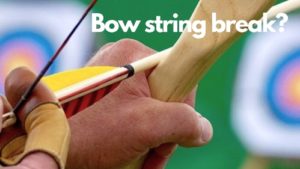- Best Archery Accessories 2024 - March 19, 2022
- Bow string:Why does it keep hitting my arm? - February 2, 2022
- Bow square: A how to guide - February 2, 2022
Never underestimate your bow when handling it as it can also fail when you misuse it. A fact is that whether you are new to the sports or a professional somewhere in your life the string has slapped you hard at least once, and possibly left you with an injury. However, there are shoddier things that can happen. However, what causes a bowstring to break. We are here to help answer the question and show you how to prevent it from happening again.
Top reasons for a break
To respond to the question of what causes bowstring breaks, we have many answers and will be discussing each one here for you to see.
Never Torque the Bow
You are aiming at the target ready to shoot the arrow and SNAP! You are standing there amazed and thinking about what happened. Many archers blame it on bow failure or parts malfunctioning. However, the reality is it all depends on your shooting form. When you torque the bow too much by twisting the line completely out of alignment, releasing it causes the string to shoot out from the cam and breaks. In turn, it can cause damage to you and other parts of the bow. Prevent making this amateur mistake today.
Always Flex Test the Arrows
Have you bought new carbon arrows? Still, make sure to flex-test them before you use it. Run your finger along the shaft and look for cracks or any sign of damage. Furthermore, you can flex it away from you and listen for creaking sounds. You can do this a dozen times before using it. As using, a dented arrow can break the shaft and line, leaving you with fragments in the face or any part of the body.
Incorrect Grip and Release Causes Line Breakage
Never hold or release the bow in an improper way, as it will leave you bruised and best to make sure you grasp it correctly. Whether you are left handed or right handed, make sure the grip is a good fit for your hand. You may find that most bows are designed for right handed people, but if you are left handed, it’s important to have the correct type. This applies to accessories too.
The Wrong Draw Length
This is another fatal mistake causing the bowstring to break. With the wrong draw length, it can lead to horrible results. Not only can it breaks the line but causes your elbow to lock and getting slapped.
Dry Firing the Bow
Never release the bowstring without using an arrow (usually called dry firing ); it is one of the biggest no-no’s. By doing this, it damages the bow, and you get slapped in places you have never been smacked before. Furthermore, it causes damage to the line and eventually causes string breaks.
As you can see these are some of the reasons that can cause a bowstring to snap. However, what can you do to prevent string snap from happening? You need to check the string for damage.

How to tell if your bow string is bad – checking for damage
For you to shoot with your bow to keep it in tiptop condition you need to do some precaution and maintenance. No matter what bow you shoot with from the longbow, traditional, crossbow, Recurve, to compound bow the strings needs checking. So how do you do this and how do you replace a broken bowstring? Find out here!
Make Time to Evaluate Your Bowstring
If you use your bow regularly for target shooting or hunting you, need to assess the line every year. You need to do this even if the bowstrings placed in storage in a pristine condition. Especially bowhunters need to check the line before use as the string damages throughout the off-season in different ways. The truth is the line can last for years, but you need to care for them before they do fail. Here are some signs the bowstring needs replacing:
- The string has a bend – check for bands in the line causing significant underlying damage. The string will be wavy, and the inside strands might be damaged causing it to break when used.
- Look for fraying – this is the number one sign that the lines damaged. The process happens naturally, as the string breaks down over time with use if you do not preserve it with wax and taking care of the bow.
- Check for separations – make sure to check the line for a division as the center serving is most likely the first one to go. Check the cams as well as it helps prevent separation in the string from taking place. You can use a loop on the middle serving to extend the use of the line.
- Look for nicked strands – no matter if only one or two of the strands are broken it is going to stretch over time causing more damage and best to replace the line.
Extend the Life of String
The best way to prevent a bowstring from popping is to wax it frequently. You can do this every time you want to use the bow. For the best lubrication, you can look at the Allen Archery Bow String Wax, but any other wax also works. Waxing the string only takes a couple of minutes by rubbing it in on all the exposed lines for a couple of seconds by using a leather glove or your fingers. Furthermore, make sure to spray some oil on the rail and cams or any other place that needs some tender loving care. If you do find you need to replace the bowstring, you will need a bow press, and it is expensive and more accessible to pay someone to do it.
Other Causes of Bowstring Damage
- Heat and moisture cause a lot of damage to the string especially during the off-season if you are not using it. With prolonged humidity and heat, exposure makes the line frail and weak. That is why it is essential to keep the bowstring waxed.
- Another big culprit is sun damage, and you should never leave your string lying directly in the sun.
- Buying improper strings is another cause for the bowstring to damage and is a significant safety risk at the same time.
- Even mice can wreak havoc with the bowstring as they gnaw on everything and best to keep an eye out for them.
Frequently Asked Questions
We hope that the above information helps you to keep your bowstring maintained preventing it from breaking. Maybe you have some other questions on your mind. Here we have some of the FAQ from our devoted users.
When should you replace the bowstring?
If you do regular bow maintenance, there is no need for replacing the bowstring frequently. Even if you are a competitive archer practicing every day, you may only need to replace it every few years. Always lube the line to keep it up to standard and check for any damage before using.
How long can a bowstring last?
The use of a bowstring depends on how often you use your bow. Some users can get extended use out of the line before replacing it. However, manufacturers recommend replacing it after 2,500 shots or every 18 months and the mileage can vary.
How frequently should you lube the string of the bow?
We advise you to wax your bowstring every time you take your bow as it only takes a couple of minutes and extends the lifespan. Alternatively, you can also lube it after shooting thirty arrows before shooting further. Furthermore, it will improve your performance when using the bow.
How do you determine the correct bowstring length?
No matter what type of bow you use, you can use the AMO length to get the correct length, or you can measure it manually. For a longbow, hunting bows or Recurve, the Archery Manufacturers and Merchants Organization length on the bow is helpful. The AMO is the length of the bow from the tip to the tip.
The correct length on a longbow is three-inches less than the AMO. For a Recurve, it is four-inches less than the AMO. For the longbow, you will need 55-inches of bowstring while the Recurve uses 54-inches. So before you buy the string from your local archery supplier always make sure to clarify whether they sell it according to the length of the AMO or the actual length needed. Alternatively, you can also check the inscription on your bow.
If the AMO label is missing and you need to find the correct length, you will need to figure it out manually. Take a tape measure along the curve of your bow limbs from the string groove to the string groove. By doing this, you will get the correct length. You can also measure the bow from tip to tip to find the AMO and subtract it according to the bow you have. Always measure across the limbs and not into the curve of the handle.
However, measuring a compound bow is a bit trickier, and you will need to place it in a bow press. Now you need to take a piece of string and make a loop. Place it on the peg on the cam and wrap it around it. Now bring it to the other pin on the opposite side of your bow.
Now you need to make the cams look similar by adjusting the brace height giving it a realistic feel on how the bow looks fully strung. At this time take a marker and mark the line at the peg found opposite the loop. Now measure the length of the line from the loop to the mark. This gives you the proper length needed to buy the string.
Final Thoughts
By doing all of the above, you can prevent bowstring damage and find a suitable length for your bow to ensure it works correctly at all times without causing bodily harm when used. Enjoy your target shooting or bowhunting until next time we meet here again.
